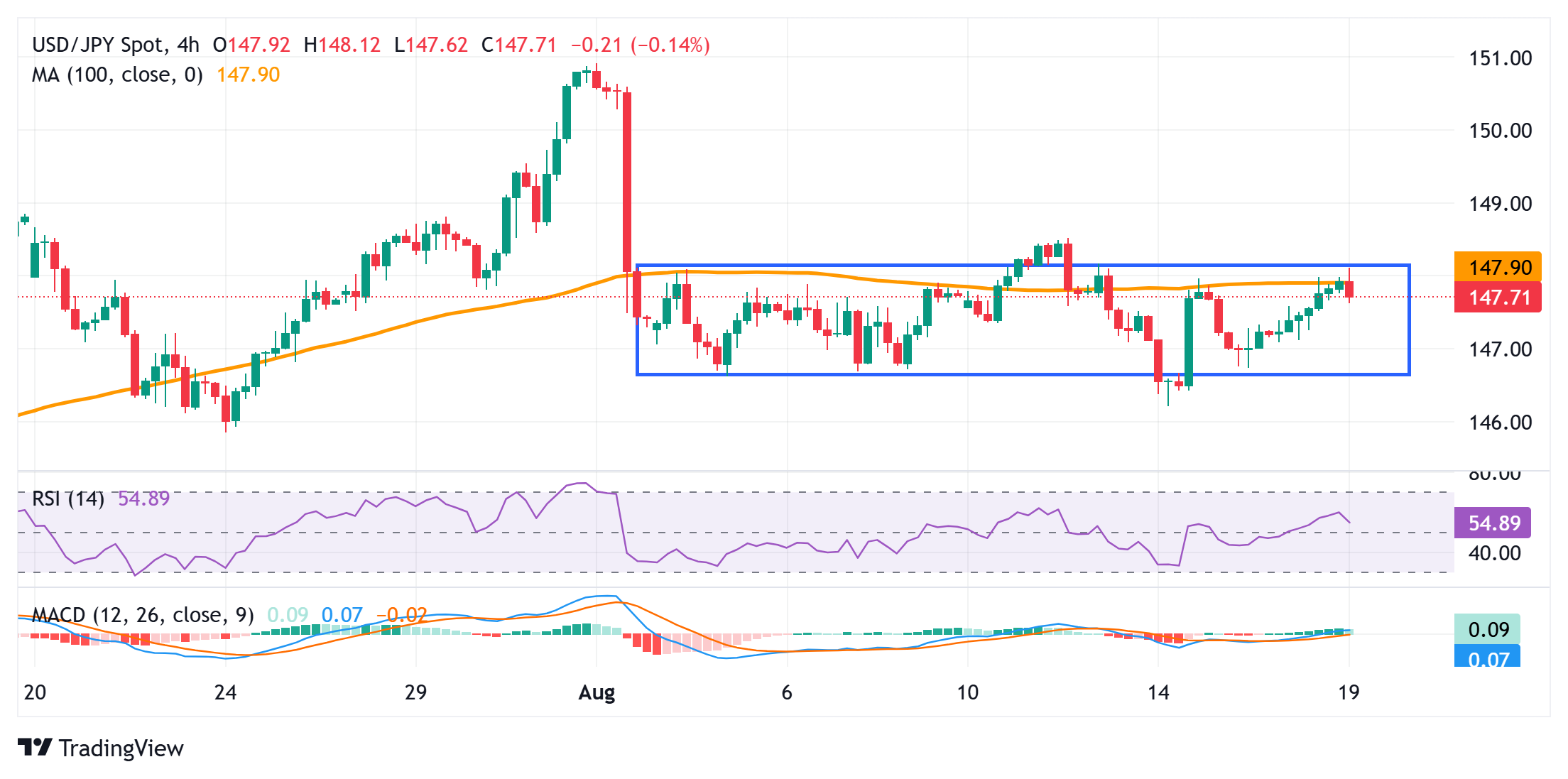Created
: 2025.08.19














![]() 2025.08.19 11:40
2025.08.19 11:40
The Japanese Yen (JPY) is seen oscillating in a range against its American counterpart during the Asian session on Tuesday amid mixed fundamental cues. The growing acceptance is that the Bank of Japan (BoJ) will stick to its policy normalization path and hike interest rates by the year-end. Moreover, the cautious market mood acts as a tailwind for the JPY. Apart from this, the lack of follow-through US Dollar (USD) buying caps the USD/JPY pair near the 148.00 mark. Meanwhile, the BoJ's hawkish outlook marks a significant divergence in comparison to expectations that the US Federal Reserve (Fed) will resume its rate-cutting cycle in September. This keeps a lid on the overnight USD rally and further benefits the lower-yielding JPY.
However, hopes for an early deal to end the prolonged Russia-Ukraine war seem to undermine traditional safe-haven assets and could act as a headwind for the JPY. Traders now look to the release of flash PMIs on Thursday for a fresh insight into the global economic health, which, in turn, will influence the risk sentiment. The focus, however, will remain glued to FOMC Minutes on Wednesday and Fed Chair Jerome Powell's speech at the Jackson Hole Symposium for more cues about the future rate-cut path. The outlook will drive the USD demand and provide some meaningful impetus to the USD/JPY pair. In the meantime, the fundamental backdrop warrants some caution for aggressive traders and before placing directional bets.

The USD/JPY pair's range-bound price action witnessed over the past two weeks or so might be categorized as a consolidation phase amid neutral technical indicators on the daily chart. Hence, it will be prudent to wait for an eventual break on either side before positioning for the next leg of a directional move.
Meanwhile, a sustained strength and acceptance above the 148.00 mark would be seen as a key trigger for the USD/JPY bulls. This should pave the way for gains towards the 148.55-148.60 region, or the 50% retracement level of the downfall from the monthly high, en route to the 149.00 round-figure mark.
On the flip side, any corrective slide could find decent support near the 147.10-147.00 area. A convincing break below could make the USD/JPY pair vulnerable to retest the multi-week low, around the 146.20 zone, touched last Thursday. A subsequent slide below the 146.00 mark might shift the bias in favor of bearish traders.
The Japanese Yen (JPY) is one of the world's most traded currencies. Its value is broadly determined by the performance of the Japanese economy, but more specifically by the Bank of Japan's policy, the differential between Japanese and US bond yields, or risk sentiment among traders, among other factors.
One of the Bank of Japan's mandates is currency control, so its moves are key for the Yen. The BoJ has directly intervened in currency markets sometimes, generally to lower the value of the Yen, although it refrains from doing it often due to political concerns of its main trading partners. The BoJ ultra-loose monetary policy between 2013 and 2024 caused the Yen to depreciate against its main currency peers due to an increasing policy divergence between the Bank of Japan and other main central banks. More recently, the gradually unwinding of this ultra-loose policy has given some support to the Yen.
Over the last decade, the BoJ's stance of sticking to ultra-loose monetary policy has led to a widening policy divergence with other central banks, particularly with the US Federal Reserve. This supported a widening of the differential between the 10-year US and Japanese bonds, which favored the US Dollar against the Japanese Yen. The BoJ decision in 2024 to gradually abandon the ultra-loose policy, coupled with interest-rate cuts in other major central banks, is narrowing this differential.
The Japanese Yen is often seen as a safe-haven investment. This means that in times of market stress, investors are more likely to put their money in the Japanese currency due to its supposed reliability and stability. Turbulent times are likely to strengthen the Yen's value against other currencies seen as more risky to invest in.
![]()
Created
: 2025.08.19
![]()
Last updated
: 2025.08.19

FXStreet is a forex information website, delivering market analysis and news articles 24/7.
It features a number of articles contributed by well-known analysts, in addition to the ones by its editorial team.
Founded in 2000 by Francesc Riverola, a Spanish economist, it has grown to become a world-renowned information website.
We hope you find this article useful. Any comments or suggestions will be greatly appreciated.
We are also looking for writers with extensive experience in forex and crypto to join us.
please contact us at [email protected].
Disclaimer:
All information and content provided on this website is provided for informational purposes only and is not intended to solicit any investment. Although all efforts are made in order to ensure that the information is correct, no guarantee is provided for the accuracy of any content on this website. Any decision made shall be the responsibility of the investor and Myforex does not take any responsibility whatsoever regarding the use of any information provided herein.
The content provided on this website belongs to Myforex and, where stated, the relevant licensors. All rights are reserved by Myforex and the relevant licensors, and no content of this website, whether in full or in part, shall be copied or displayed elsewhere without the explicit written permission of the relevant copyright holder. If you wish to use any part of the content provided on this website, please ensure that you contact Myforex.
Myforex uses cookies to improve the convenience and functionality of this website. This website may include cookies not only by us but also by third parties (advertisers, log analysts, etc.) for the purpose of tracking the activities of users. Cookie policy